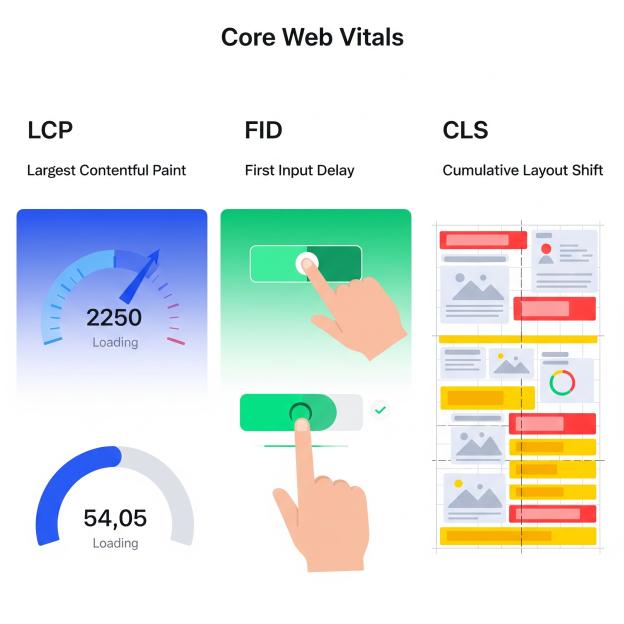After publishing what you believe is the most comprehensive, valuable content your industry has ever seen. Your team spent months researching, writing, and perfecting every detail. But three months later, it’s buried on page five of Google, invisible to your target audience, while inferior content ranks at the top.
The crushing reality hits – without proper technical SEO, even the most brilliant content becomes digital ghost towns. Your high-stakes content deserves high-stakes technical optimization.
Table of Contents
- Understanding Technical SEO for High-Value Content
- Core Technical SEO Fundamentals
- Website Architecture for High-Stakes Content
- Page Speed Optimization Strategies
- Mobile-First Technical Implementation
- Advanced Schema Markup for Content
- Internal Linking for Content Authority
- Technical Content Optimization
- Crawlability and Indexation Management
- Technical SEO Monitoring and Maintenance
- Common Technical SEO Mistakes to Avoid
- Advanced Technical SEO Strategies
Understanding Technical SEO for High-Value Content
Technical SEO forms the invisible foundation that determines whether your high-stakes content succeeds or fails in search results. Unlike traditional SEO that focuses on keywords and content quality, technical SEO ensures search engines can properly discover, crawl, understand, and rank your valuable content.
What Makes Content “High-Stakes”?
High-stakes content represents your organization’s most critical digital assets. This includes:
- Revenue-driving content like product pages, service descriptions, and conversion-focused landing pages
- Authority-building pieces such as comprehensive guides, research reports, and industry analyses
- Brand-defining content including company announcements, thought leadership articles, and PR materials
- Time-sensitive materials like news releases, event pages, and seasonal campaigns
The Technical SEO-Content Success Connection
Search engines evaluate content through multiple technical lenses before considering its quality or relevance. Google’s algorithms assess technical factors including:
- Site performance metrics like Core Web Vitals and page loading speeds
- Mobile responsiveness and user experience across devices
- Content structure through proper HTML markup and schema implementation
- Site architecture including URL structure and internal linking patterns
- Crawling efficiency determining how easily bots can discover and process content
Research from various SEO studies consistently shows that websites with strong technical foundations achieve 40-60% better search performance compared to technically flawed sites, regardless of content quality.
Core Technical SEO Fundamentals
Website Performance Optimization
Page speed directly impacts both search rankings and user engagement. Google’s Core Web Vitals have become ranking factors, making performance optimization essential for high-stakes content success.
Key Performance Metrics to Monitor:
- Largest Contentful Paint (LCP): Should load within 2.5 seconds
- First Input Delay (FID): Must be less than 100 milliseconds
- Cumulative Layout Shift (CLS): Should remain below 0.1
Performance Optimization Strategies:
- Image Optimization
- Use next-generation formats like WebP and AVIF
- Implement responsive images with srcset attributes
- Enable lazy loading for below-the-fold content
- Compress images without quality loss using tools like TinyPNG
- Code Optimization
- Minify CSS, JavaScript, and HTML files
- Remove unused code and dependencies
- Implement critical CSS for above-the-fold content
- Use asynchronous loading for non-critical scripts
- Server-Side Improvements
- Enable browser caching with appropriate expiration headers
- Implement GZIP compression for text-based files
- Use Content Delivery Networks (CDNs) for global content distribution
- Optimize database queries and server response times
HTTPS Implementation and Security
Security has become a confirmed Google ranking factor, making HTTPS implementation mandatory for high-stakes content.
SSL Certificate Best Practices:
- Install SSL certificates from reputable certificate authorities
- Implement HSTS (HTTP Strict Transport Security) headers
- Ensure all internal links use HTTPS protocol
- Set up proper 301 redirects from HTTP to HTTPS versions
- Monitor mixed content warnings and resolve security issues
URL Structure and Organization
Clean, descriptive URLs enhance both user experience and search engine understanding of content hierarchy.
URL Optimization Guidelines:
- Use descriptive, keyword-rich URLs that reflect content topics
- Implement consistent URL structure across the website
- Avoid dynamic parameters when possible
- Use hyphens to separate words in URLs
- Keep URLs concise while maintaining descriptiveness
Website Architecture for High-Stakes Content
Information Architecture Planning
Effective website architecture ensures search engines and users can efficiently navigate to your most important content.
Hierarchical Structure Design:
Create logical content hierarchies that follow user intent patterns:
- Homepage → Category Pages → Subcategory Pages → Individual Content Pages
- Limit deep nesting to maintain link equity flow
- Ensure important content remains within 3-4 clicks from the homepage
- Implement breadcrumb navigation for complex site structures
Category and Tag Implementation
Strategic categorization helps search engines understand content relationships and topical authority.
Best Practices for Content Organization:
- Create specific, non-overlapping category structures
- Use descriptive category names that reflect user search behavior
- Implement tag systems for cross-category content connections
- Avoid orphaned pages without clear navigation paths
- Maintain consistent taxonomy across content types
Faceted Navigation Optimization
E-commerce and content-heavy sites often require faceted navigation, which can create technical SEO challenges.
Faceted Navigation Solutions:
- Use rel=”nofollow” for filter combinations that create thin content
- Implement canonical tags for duplicate content created by filters
- Create SEO-friendly URLs for valuable filter combinations
- Use robots.txt to control crawling of parameter-heavy pages
- Implement AJAX filtering with proper URL updating
Page Speed Optimization Strategies
Critical Rendering Path Optimization
The critical rendering path represents the sequence of steps browsers take to render initial page content.
Optimization Techniques:
- Minimize Critical Resources
- Reduce the number of critical CSS and JavaScript files
- Inline critical CSS directly in HTML for above-the-fold content
- Defer non-critical CSS loading until after initial render
- Prioritize loading of essential fonts and resources
- Resource Loading Optimization
- Use preload hints for critical resources
- Implement prefetch for likely next-page resources
- Optimize font loading with font-display: swap
- Minimize render-blocking JavaScript execution
Advanced Caching Strategies
Intelligent caching reduces server load and improves content delivery speed for returning visitors.
Caching Implementation Levels:
- Browser Caching
- Set appropriate cache-control headers for different content types
- Use versioning for cache busting during content updates
- Implement ETags for efficient cache validation
- Server-Side Caching
- Deploy object caching for database-driven content
- Implement full-page caching for static content
- Use edge caching through CDN networks
- Configure reverse proxy caching for dynamic content
- Application-Level Caching
- Cache database query results
- Store computed values to avoid recalculation
- Implement fragment caching for partial page elements
Third-Party Script Management
External scripts often become performance bottlenecks for content-heavy websites.
Script Optimization Strategies:
- Audit all third-party scripts for necessity and performance impact
- Load analytics and tracking scripts asynchronously
- Use resource hints to preconnect to external domains
- Implement lazy loading for non-critical third-party content
- Monitor third-party script performance regularly
Mobile-First Technical Implementation
Responsive Design Technical Requirements
Google’s mobile-first indexing makes mobile optimization critical for content success.
Technical Mobile Optimization:
- Viewport Configuration
<meta name="viewport" content="width=device-width, initial-scale=1"> - Flexible Grid Systems
- Use CSS flexbox and grid for responsive layouts
- Implement fluid typography with viewport units
- Design touch-friendly interface elements
- Ensure adequate spacing between clickable elements
- Progressive Enhancement
- Start with mobile-first CSS design
- Add desktop enhancements through media queries
- Ensure core functionality works without JavaScript
- Test across multiple device types and screen sizes
Mobile Page Speed Optimization
Mobile users have different performance expectations and network constraints.
Mobile-Specific Optimizations:
- Optimize images for high-density displays
- Minimize above-the-fold content size
- Implement progressive image loading
- Reduce JavaScript execution time
- Optimize for slower network connections
Accelerated Mobile Pages (AMP) Considerations
While AMP adoption has decreased, understanding its principles helps with mobile optimization.
AMP-Inspired Optimizations:
- Limit JavaScript execution and complexity
- Prioritize content loading over interactive elements
- Use efficient CSS practices without excessive animations
- Implement lazy loading for non-critical content
- Focus on content-first mobile experiences
Advanced Schema Markup for Content
Content-Specific Schema Implementation
Schema markup helps search engines understand content context and purpose.
High-Impact Schema Types for Content:
- Article Schema
{ "@context": "https://schema.org", "@type": "Article", "headline": "Your Article Title", "author": { "@type": "Person", "name": "Author Name" }, "datePublished": "2025-01-01", "dateModified": "2025-01-15", "publisher": { "@type": "Organization", "name": "Your Organization", "logo": "https://example.com/logo.png" } } - FAQ Schema
- Implement for content with question-answer formats
- Include relevant questions users commonly ask
- Structure answers concisely and helpfully
- Monitor FAQ rich snippet performance
- How-To Schema
- Use for instructional and tutorial content
- Include step-by-step instructions
- Add time estimates and required materials
- Optimize for voice search queries
Organization and Brand Schema
Establish entity relationships and brand authority through comprehensive schema implementation.
Brand Authority Schema Elements:
- Organization schema with complete business information
- Logo and brand imagery markup
- Social media profile connections
- Contact information and business hours
- Awards and recognition markup
Review and Rating Schema
Build content credibility through review and rating markup.
Review Schema Best Practices:
- Implement aggregate rating schema for content collections
- Include individual review markup for detailed feedback
- Ensure review authenticity and compliance with guidelines
- Monitor review rich snippet appearance and performance
Internal Linking for Content Authority
Strategic Link Architecture
Internal linking distributes page authority and helps establish content relationships.
Link Architecture Principles:
- Hub and Spoke Model
- Create comprehensive topic hubs that link to related subtopic pages
- Link back from subtopic pages to relevant hub pages
- Establish clear content hierarchies through link patterns
- Use descriptive anchor text that reflects target page content
- Content Clusters
- Group related content around central pillar pages
- Create extensive cross-linking between cluster content
- Use consistent linking patterns for topical authority
- Monitor internal link equity distribution
Anchor Text Optimization
Strategic anchor text usage helps search engines understand content relationships.
Anchor Text Best Practices:
- Use descriptive, keyword-rich anchor text naturally
- Vary anchor text for links to the same page
- Avoid over-optimization with exact match keywords
- Include branded and natural language variations
- Monitor anchor text distribution patterns
Link Equity Distribution
Ensure high-value content receives appropriate internal link support.
Link Equity Strategies:
- Prioritize linking to high-stakes content from authoritative pages
- Use homepage and navigation links strategically
- Implement contextual linking within relevant content
- Monitor and adjust linking patterns based on performance data
- Remove or redirect broken internal links promptly
Technical Content Optimization
HTML Structure and Semantic Markup
Proper HTML structure helps search engines understand content hierarchy and meaning.
Semantic HTML Best Practices:
- Header Tag Hierarchy
- Use H1 tags for main page titles (one per page)
- Implement logical H2-H6 structure for content organization
- Include target keywords naturally in header tags
- Ensure header hierarchy reflects content importance
- Content Markup
- Use appropriate HTML5 semantic elements (article, section, aside)
- Implement proper list structures for enumerated content
- Use emphasis tags (strong, em) appropriately
- Include alt text for all images with descriptive content
Image SEO for Content
Images enhance content value but require proper optimization for search performance.
Image Optimization Strategies:
- Technical Image Requirements
- Use descriptive, keyword-rich file names
- Implement proper alt text describing image content
- Include title attributes for additional context
- Use appropriate image dimensions and compression
- Advanced Image SEO
- Create image sitemaps for content-heavy sites
- Implement structured data for images
- Use caption text to provide additional context
- Optimize images for Google Images search results
Video Content Technical SEO
Video content requires specific technical optimizations for search visibility.
Video SEO Implementation:
- Create video sitemaps with detailed metadata
- Implement VideoObject schema markup
- Provide accurate video transcripts
- Use descriptive video file names and thumbnails
- Optimize video loading for page speed performance
Crawlability and Indexation Management
XML Sitemap Optimization
XML sitemaps guide search engine crawling and indexation of high-stakes content.
Sitemap Best Practices:
- Sitemap Structure
- Create separate sitemaps for different content types
- Include only indexable, high-quality pages
- Update sitemaps automatically when content changes
- Submit sitemaps through Google Search Console
- Sitemap Metadata
- Include last modification dates for content freshness signals
- Set appropriate priority values for important pages
- Use change frequency indicators appropriately
- Monitor sitemap processing and error reports
Robots.txt Configuration
Robots.txt files control search engine crawling behavior and resource allocation.
Robots.txt Optimization:
- Block crawling of low-value or duplicate content
- Prevent indexation of admin and development areas
- Allow crawling of important content and resources
- Include sitemap locations in robots.txt files
- Test robots.txt directives before implementation
Canonical Tag Implementation
Canonical tags prevent duplicate content issues and consolidate ranking signals.
Canonical Tag Strategies:
- Self-Referencing Canonicals
- Include canonical tags on all indexable pages
- Use absolute URLs for canonical references
- Ensure canonical URLs are accessible and properly formatted
- Cross-Domain Canonicals
- Implement for syndicated or republished content
- Use when content appears on multiple domains
- Monitor canonical tag recognition and effectiveness
Meta Robots and Indexation Control
Control how search engines handle specific content through meta robots directives.
Meta Robots Implementation:
- Use noindex for thin or duplicate content pages
- Implement nofollow for untrusted external links
- Use noarchive to prevent cached page storage
- Monitor indexation status through Search Console
Technical SEO Monitoring and Maintenance
Performance Monitoring Tools
Regular monitoring ensures technical SEO implementations remain effective over time.
Essential Monitoring Tools:
- Google Search Console
- Monitor crawling and indexation status
- Track search performance and click-through rates
- Identify and resolve technical issues
- Submit sitemaps and request indexation
- Google PageSpeed Insights
- Monitor Core Web Vitals performance
- Identify performance optimization opportunities
- Track mobile and desktop speed metrics
- Implement recommended optimizations
- Technical SEO Audit Tools
- Screaming Frog for comprehensive site crawling
- Ahrefs or SEMrush for technical SEO monitoring
- GTmetrix for detailed performance analysis
- Lighthouse for comprehensive auditing
Regular Technical Audits
Systematic auditing identifies and resolves technical issues before they impact content performance.
Audit Frequency and Scope:
- Conduct comprehensive technical audits quarterly
- Perform monthly performance and speed checks
- Monitor weekly for critical technical issues
- Implement automated monitoring for key metrics
Issue Resolution Workflows
Establish systematic approaches for identifying and resolving technical SEO problems.
Issue Resolution Process:
- Issue Identification
- Set up automated monitoring alerts
- Conduct regular manual reviews
- Monitor search console for warnings
- Track performance metric changes
- Priority Assessment
- Evaluate impact on high-stakes content
- Assess potential traffic and ranking effects
- Consider user experience implications
- Determine resolution timeline requirements
- Resolution Implementation
- Develop technical solutions for identified issues
- Test fixes in staging environments
- Implement solutions with minimal site disruption
- Monitor effectiveness of implemented fixes
Common Technical SEO Mistakes to Avoid
Critical Implementation Errors
Understanding common technical SEO mistakes helps prevent costly content performance issues.
High-Impact Mistakes:
- Blocking Important Content
- Accidentally blocking pages with robots.txt
- Using noindex tags on valuable content
- Implementing canonical tags incorrectly
- Restricting crawling of critical resources
- Performance Killers
- Ignoring mobile page speed optimization
- Loading excessive third-party scripts
- Using unoptimized images and media files
- Implementing render-blocking resources incorrectly
- Structure Problems
- Creating orphaned pages without internal links
- Implementing confusing URL structures
- Using duplicate title tags and meta descriptions
- Neglecting proper header tag hierarchy
Content-Specific Technical Issues
High-stakes content faces unique technical challenges that require specific attention.
Content Technical Pitfalls:
- Failing to implement proper schema markup for content types
- Neglecting image optimization for content-heavy pages
- Creating thin or duplicate content through poor categorization
- Implementing pagination incorrectly for long-form content
- Using inappropriate redirect chains for updated content
Mobile-First Implementation Failures
Mobile-first indexing makes mobile technical issues particularly damaging.
Mobile Implementation Mistakes:
- Hiding important content on mobile versions
- Using different URLs for mobile and desktop content
- Implementing slow-loading mobile experiences
- Creating difficult mobile navigation structures
- Failing to optimize for touch interactions
Advanced Technical SEO Strategies
JavaScript SEO Optimization
Modern websites increasingly rely on JavaScript, requiring specialized optimization approaches.
JavaScript SEO Best Practices:
- Server-Side Rendering (SSR)
- Implement SSR for critical content and navigation
- Use pre-rendering for static content pages
- Ensure content accessibility without JavaScript
- Monitor search engine JavaScript rendering
- Client-Side Optimization
- Use progressive enhancement for JavaScript functionality
- Implement proper loading states and error handling
- Ensure important content loads quickly
- Test JavaScript rendering with search engine tools
International SEO Technical Implementation
Global content requires sophisticated technical SEO approaches.
International Technical Strategies:
- Implement hreflang tags for multi-language content
- Use appropriate URL structures for international sites
- Configure geotargeting in Search Console
- Optimize for local search engines beyond Google
- Handle currency and regional content variations
Advanced Schema and Structured Data
Sophisticated schema implementation enhances content understanding and visibility.
Advanced Schema Strategies:
- Entity Relationships
- Connect related entities through schema markup
- Implement comprehensive organization and person schemas
- Use schema to establish topical authority
- Create linked data relationships between content pieces
- Custom Schema Implementation
- Develop industry-specific schema markup
- Implement JSON-LD for complex data structures
- Use schema markup for enhanced rich snippets
- Monitor schema effectiveness and rich snippet performance
Core Web Vitals Optimization
Google’s Core Web Vitals represent critical ranking factors for content success.
Advanced Core Web Vitals Strategies:
- Largest Contentful Paint (LCP) Optimization
- Optimize critical resource loading priorities
- Implement advanced image optimization techniques
- Use resource hints strategically
- Minimize render-blocking resources
- Cumulative Layout Shift (CLS) Prevention
- Reserve space for dynamic content loading
- Use CSS aspect-ratio for media elements
- Avoid inserting content above existing content
- Test layout stability across different devices
- First Input Delay (FID) Improvement
- Minimize JavaScript execution time
- Use web workers for heavy computations
- Implement efficient event handlers
- Optimize third-party script loading
Conclusion
Technical SEO forms the critical foundation that determines whether your high-stakes content achieves its full potential in search results. By implementing comprehensive technical optimizations across site architecture, performance, mobile experience, and content structure, you create the ideal environment for content success.
The strategies outlined in this guide provide a systematic approach to technical SEO that supports content marketing goals while delivering exceptional user experiences. Remember that technical SEO is an ongoing process requiring regular monitoring, testing, and optimization to maintain peak performance.
Start by conducting a comprehensive technical audit of your current website, prioritizing fixes that impact your most valuable content. Implement changes systematically, monitoring performance improvements at each step. With consistent attention to technical SEO fundamentals and advanced optimization strategies, your high-stakes content will achieve the search visibility and user engagement it deserves.
Success in technical SEO requires balancing multiple priorities: search engine requirements, user experience expectations, and business objectives. By maintaining this balance while implementing the strategies discussed throughout this guide, you’ll build a technical foundation that supports long-term content marketing success and sustainable organic growth.







